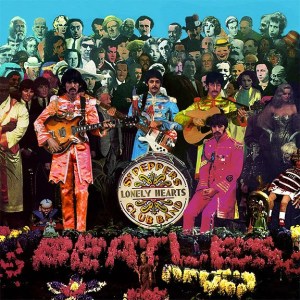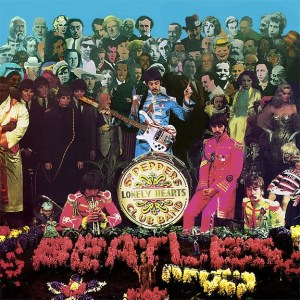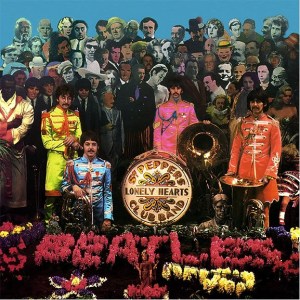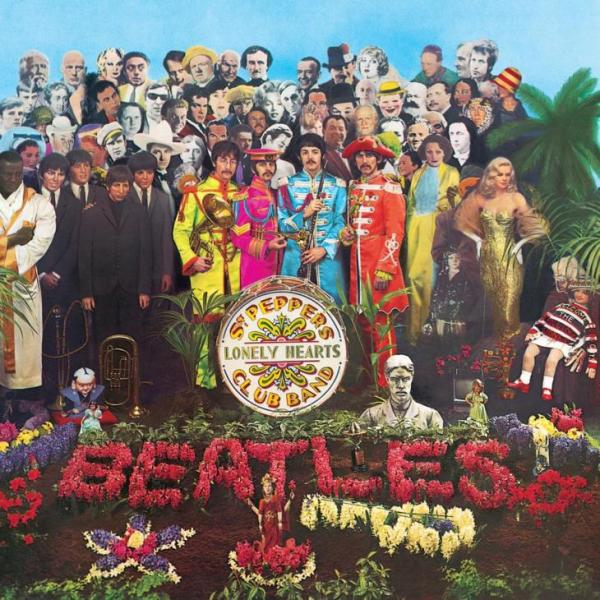FRESH AIR: Giles Martin says he included outtakes and raw performances in the new box set to show “how human the making of Sgt. Pepper was.” The original album was produced by Martin’s father, George. MORE
ROLLING STONE: The surviving band members and their legatees have authorized the reconsideration of a major canonical work: Sgt. Pepper’s Lonely Hearts Club Band, originally released 50 years ago on June 1st, 1967, in England, and the following day in the U.S. The new Pepper comes in various packages: single and double CDs, a deluxe box of four CDs and two DVDs (containing videos and 5.1 surround  mixes of the original album), as well as a double LP that, like most versions here, includes several of the album’s original developing and alternate tracks. All editions feature a stereo remix by Giles Martin (George Martin died in 2016, at 90) and Abbey Road audio engineer Sam Okell. The ambition might seem a bit of a risk or even redundant. After all, Sgt. Pepper has been considered by many as not just rock’s greatest moment, but also as a central touchstone for the 1960s – an exemplar for a generation that was forging new ideals, and granting themselves new permissions, including the use of psychedelic drugs. The Beatles had already done a lot to make that change possible, but Sgt. Pepper – coming along at a time when many thought the Beatles superfluous, in the face of other new adventurous bands and records – crystallized it all. Langdon Winner later wrote in The Rolling Stone Illustrated History of Rock & Roll: “For a brief while, the irreparable fragmented consciousness of the West was unified, at least in the minds of the young.”
mixes of the original album), as well as a double LP that, like most versions here, includes several of the album’s original developing and alternate tracks. All editions feature a stereo remix by Giles Martin (George Martin died in 2016, at 90) and Abbey Road audio engineer Sam Okell. The ambition might seem a bit of a risk or even redundant. After all, Sgt. Pepper has been considered by many as not just rock’s greatest moment, but also as a central touchstone for the 1960s – an exemplar for a generation that was forging new ideals, and granting themselves new permissions, including the use of psychedelic drugs. The Beatles had already done a lot to make that change possible, but Sgt. Pepper – coming along at a time when many thought the Beatles superfluous, in the face of other new adventurous bands and records – crystallized it all. Langdon Winner later wrote in The Rolling Stone Illustrated History of Rock & Roll: “For a brief while, the irreparable fragmented consciousness of the West was unified, at least in the minds of the young.”
Additionally, Sgt. Pepper’s groundbreaking sonics – its mix of pioneering textures, complex composition and inventive recording techniques –also won the album standing as a legitimate art form that revised and extended classical music’s archetypes. (This achievement also imbued much of rock itself with a new prestige and aspiration.) In part, the unprecedented acclaim resulted from Paul McCartney’s insistence on the album as a conceptual song cycle that existed as a whole entity: The Beatles, posed in ornate Victorian brass-band military costumery on the cover, were playing a fictional band, singing from perspectives free of any indebtedness to their prior musical sensibility and well-established images. (Ringo Starr later described it as “a bunch of songs and you stick two bits of ‘Pepper’ on it and it’s a concept album. It worked because we said it worked.”)
But that was 50 years ago. A lot changed – including the Beatles, who ended acrimoniously in 1970. What can we learn now from Sgt. Pepper’s new incarnation? As it turns out, Giles Martin reveals considerable new wonders – particularly in his stereo remix of the original album (which appears in all the new editions, and as a standalone disc and digital download). The remix, in fact, provides a long overdue epiphany. Martin observes in his liner notes: “The original Sgt. Pepper’s Lonely Hearts Club Band was primarily mixed as a mono album. All care and attention were applied to the mono LP, with the Beatles present for all the mixes. … Almost as an afterthought, the stereo album was mixed very quickly without the Beatles at the sessions. Yet it is the stereo album that most people listen to today.” In other words, popular music’s most elaborate and intricate creation – and one that helped end the mono era – wasn’t made to be heard in stereo. MORE
and intricate creation – and one that helped end the mono era – wasn’t made to be heard in stereo. MORE
NEW YORK TIMES JUNE 18, 1967: With one important exception, “Sergeant Pepper” is precious but devoid of gems. “A Day in the Life” is such a radical departure from the spirit of the album that it almost deserves its peninsular position (following the reprise of the “Sergeant Pepper” theme, it comes almost as an afterthought). It has nothing to do with posturing or put-on. It is a deadly earnest excursion in emotive music with a chilling lyric. Its orchestration is dissonant but sparse, and its mood is not whimsical nostalgia but irony.
With it, the Beatles have produced a glimpse of modern city life, that is terrifying. It stands as one of the most important Lennon-McCartney compositions, and it is a historic Pop event. “A Day in the Life” starts in a description of suicide. With the same conciseness displayed in “Eleanor Rigby,” the protagonist begins: “I read the news today, oh boy.” This mild interjection is the first hint of his disillusion ment; compared with what is to follow, it is supremely ironic. “I saw the photograph,” he continues, in the voice of a melancholy choir boy:
He blew his mind out in a car
He didn’t notice that the lights had changed
A crowd of people stood and stared
They’d seen his face before
Nobody was really sure If he was from the House of Lords.
“A Day in the Life” could never make the Top 40, although it may influence a great many songs which do. Its lyric is sure to bring a sudden surge of Pop tragedy. The aimless, T. S. Eliot-like crowd, forever confronting pain and turning away, may well become a common symbol. And its narrator, subdued by the totality of his despair, may reappear in countless compositions as the silent, withdrawn hero.
Musically, there are already indications that the intense atonality of “A Day in the Life” is a key to the sound of 1967. Electronic-rock, with its aim of staggering an audience, has arrived in half-a-dozen important new releases, None of these songs has the controlled intensity of “A Day in the Life,” but the willingness of many restrained musicians to “let go” means that serious aleatory-pop may be on the way.
Ultimately, however, it is the uproar over the alleged influence of drugs on the Beatles which may prevent “A Day in the Life” from reaching the mass audience. The song’s refrain, “I’d like to turn you on,” has rankled disk jockeys supersensitive to “hidden subversion” in rock ‘n roll. In fact, a case can be made within the very structure of “A Day in the Life” for the belief that the Beatles — like so many Pop  composers—are aware of the highs and lows of consciousness.
composers—are aware of the highs and lows of consciousness.
The song is built on a series of tense, melancholic passages, followed by soaring releases. In the opening stanza, for instance, John’s voice comes near to cracking with despair. But after the invitation, “I’d like to turn you on,” the Beatles have inserted an extraordinary atonal thrust which is shocking, even painful, to the ears. But it brilliantly encases the song and, if the refrain preceding it suggests turning on, the crescendo parallels a drug-induced “rush.”
The bridge begins in a staccato crossfire. We feel the narrator rising, dressing and commuting by rote. The music is nervous with the dissonance of cabaret jazz. A percussive drum melts into a panting railroad chug. Then
Found my way upstairs and had a smoke
Somebody spoke and I went into a dream.
The words fade into a chant of free, spacious chords, like the initial marijuana “buzz.” But the tone becomes mysterious and then ominous. Deep strings take us on a Wagnerian descent and we are back to the original blues theme, and the original declaration, “I read the news today, oh boy.” Actually, it is difficult to see why the BBC banned “A Day in the Life,” because its message is, quite clearly, the flight from banality. It describes a profound reality, but it certainly does not glorify it. And its conclusion, though magnificent, seems to represent a negation of self. The song ends on one low, resonant note that is sustained for 40 seconds. Having achieved the absolute peace of nullification, the narrator is beyond melancholy. But there is something brooding and irrevocable about his calm. It sounds like destruction. MORE

